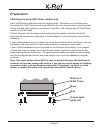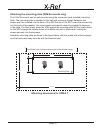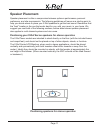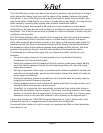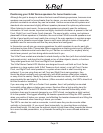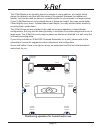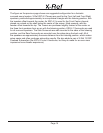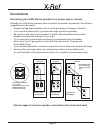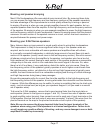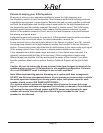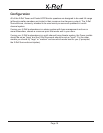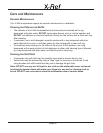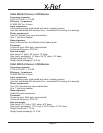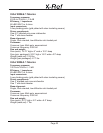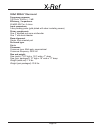
Page 17
Bi-wiring and passive bi-amping
Most X-Ref loudspeakers offer removable bi-amp terminal links. By removing these links,
you can access the high-frequency and low-frequency sections of the speaker separately
and take advantage of the improvements in sound quality offered by bi-wiring or passive
bi-amping. Bi-wiring is when you use a single amplier channel for each speaker, but run
separate speaker wires from the amplier to the high-frequency and low-frequency sections
of the speaker. Bi-amping is when you use separate ampliers to power the high-frequency
and low-frequency section of each loudspeaker. Passive bi-amping means that the passive
crossover for each section of the speaker remains in-circuit, and no line-level crossover is
required between the preamp and power amps.
Bi-wiring your X-Ref Series speakers
Many listeners hear an improvement in sound quality when bi-wiring their loudspeakers.
This improvement is likely to be more signicant when long or thin speaker wires are
required, and is more noticeable with some speakers and ampliers than with others.
In a normally connected loudspeaker, a relatively large amount of current ows into each
section of the speaker (usually much more to the low-frequency section). Since this current
all shares a single wire from the amplier to the speaker, and speaker wire has a low but
nite resistance, the current owing to each section of the speaker produces a measurable
voltage drop in the wire, which in turn modulates the overall signal in the wire. So, when
there’s a lot of loud bass, it may modulate or distort the treble, and vice versa. Since the
low-frequency portion of the speaker typically operates at much higher current levels than
the high-frequency portion, yet distortion in the mid and high frequencies is typically more
audible, the most common result is a noticeable muddying and blurring of critical midrange
and high frequencies during heavy bass passages.
By providing separate paths for current ow from the amplier to the high-frequency and
low-frequency portions of the speaker, bi-wiring eliminates this interaction and the distortion
it causes. While the differences may be subtle, bi-wiring is something that can be tried quite
easily - and at minimal cost (as long as your speakers support it, all you need is a second
set of speaker wires).
To bi-wire the X-Ref speakers, remove the bi-amp terminal links from the input plate on
each speaker (shown in the gures on pages 7 and 16). Connect two sets of speaker wires
to each amplier output terminal, then connect one set to each pair of input terminals on the
X-Ref speaker. Be sure that both sets of wires are connected “in phase” (the wires from the
plus/red terminal on the amp to the plus/red terminals on both inputs of the speaker).
Note: Be sure to remove the bi-amp terminal links from the input terminals of the
speakers when using your X-Ref speakers in a bi-wired conguration. Failure to do
so will negate any positive effects of bi-wiring, and may cause damage to one or both
ampliers if hooked up incorrectly.



